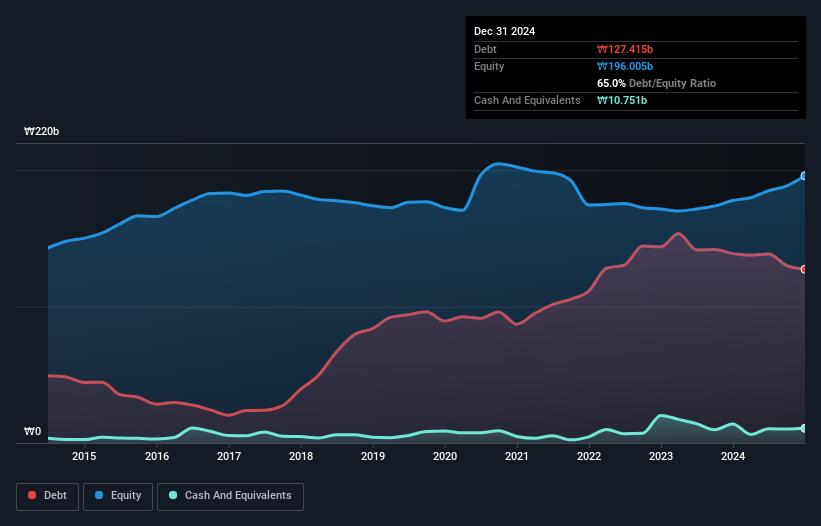Some say volatility, rather than debt, is the best way to think about risk as an investor, but Warren Buffett famously said that 'Volatility is far from synonymous with risk.' So it seems the smart money knows that debt - which is usually involved in bankruptcies - is a very important factor, when you assess how risky a company is. As with many other companies Chokwang Paint Ltd. (KRX:004910) makes use of debt. But should shareholders be worried about its use of debt?
Our free stock report includes 3 warning signs investors should be aware of before investing in Chokwang Paint. Read for free now.When Is Debt A Problem?
Debt assists a business until the business has trouble paying it off, either with new capital or with free cash flow. In the worst case scenario, a company can go bankrupt if it cannot pay its creditors. While that is not too common, we often do see indebted companies permanently diluting shareholders because lenders force them to raise capital at a distressed price. By replacing dilution, though, debt can be an extremely good tool for businesses that need capital to invest in growth at high rates of return. The first thing to do when considering how much debt a business uses is to look at its cash and debt together.
What Is Chokwang Paint's Net Debt?
You can click the graphic below for the historical numbers, but it shows that Chokwang Paint had ₩127.4b of debt in December 2024, down from ₩138.9b, one year before. However, it does have ₩10.8b in cash offsetting this, leading to net debt of about ₩116.7b.

How Strong Is Chokwang Paint's Balance Sheet?
According to the last reported balance sheet, Chokwang Paint had liabilities of ₩150.3b due within 12 months, and liabilities of ₩45.6b due beyond 12 months. On the other hand, it had cash of ₩10.8b and ₩45.6b worth of receivables due within a year. So it has liabilities totalling ₩139.5b more than its cash and near-term receivables, combined.
This deficit casts a shadow over the ₩64.2b company, like a colossus towering over mere mortals. So we definitely think shareholders need to watch this one closely. After all, Chokwang Paint would likely require a major re-capitalisation if it had to pay its creditors today.
Check out our latest analysis for Chokwang Paint
We measure a company's debt load relative to its earnings power by looking at its net debt divided by its earnings before interest, tax, depreciation, and amortization (EBITDA) and by calculating how easily its earnings before interest and tax (EBIT) cover its interest expense (interest cover). This way, we consider both the absolute quantum of the debt, as well as the interest rates paid on it.
Weak interest cover of 0.40 times and a disturbingly high net debt to EBITDA ratio of 12.8 hit our confidence in Chokwang Paint like a one-two punch to the gut. The debt burden here is substantial. Worse, Chokwang Paint's EBIT was down 35% over the last year. If earnings keep going like that over the long term, it has a snowball's chance in hell of paying off that debt. When analysing debt levels, the balance sheet is the obvious place to start. But it is Chokwang Paint's earnings that will influence how the balance sheet holds up in the future. So when considering debt, it's definitely worth looking at the earnings trend. Click here for an interactive snapshot.
Finally, a business needs free cash flow to pay off debt; accounting profits just don't cut it. So the logical step is to look at the proportion of that EBIT that is matched by actual free cash flow. Over the last two years, Chokwang Paint actually produced more free cash flow than EBIT. That sort of strong cash conversion gets us as excited as the crowd when the beat drops at a Daft Punk concert.
Our View
To be frank both Chokwang Paint's EBIT growth rate and its track record of staying on top of its total liabilities make us rather uncomfortable with its debt levels. But at least it's pretty decent at converting EBIT to free cash flow; that's encouraging. Taking into account all the aforementioned factors, it looks like Chokwang Paint has too much debt. That sort of riskiness is ok for some, but it certainly doesn't float our boat. When analysing debt levels, the balance sheet is the obvious place to start. However, not all investment risk resides within the balance sheet - far from it. To that end, you should learn about the 3 warning signs we've spotted with Chokwang Paint (including 1 which shouldn't be ignored) .
Of course, if you're the type of investor who prefers buying stocks without the burden of debt, then don't hesitate to discover our exclusive list of net cash growth stocks, today.
New: AI Stock Screener & Alerts
Our new AI Stock Screener scans the market every day to uncover opportunities.
• Dividend Powerhouses (3%+ Yield)
• Undervalued Small Caps with Insider Buying
• High growth Tech and AI Companies
Or build your own from over 50 metrics.
Have feedback on this article? Concerned about the content? Get in touch with us directly. Alternatively, email editorial-team (at) simplywallst.com.
This article by Simply Wall St is general in nature. We provide commentary based on historical data and analyst forecasts only using an unbiased methodology and our articles are not intended to be financial advice. It does not constitute a recommendation to buy or sell any stock, and does not take account of your objectives, or your financial situation. We aim to bring you long-term focused analysis driven by fundamental data. Note that our analysis may not factor in the latest price-sensitive company announcements or qualitative material. Simply Wall St has no position in any stocks mentioned.
About KOSE:A004910
Chokwang Paint
Manufactures and sells paints and chemicals in South Korea and internationally.
Moderate risk and slightly overvalued.
Market Insights
Community Narratives



